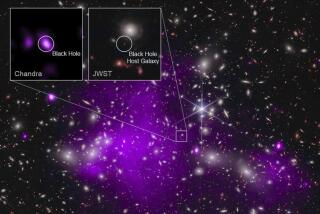Astronomers Star-Struck Over Discovery
- Share via
Astronomers have discovered what may be the largest galaxy in the known universe, a mammoth cluster of stars that stretches for 6 million light years--more than 60 times the size of the Milky Way, it was reported today.
The giant object is located in the heart of a cluster of galaxies known as Abell 2029, a team of astronomers reported in the journal Science.
The object is 1 billion light years from Earth--that is, the distance light travels in 1 billion years at a speed of 186,000 miles per second.
Using a 36-inch telescope at the Kitt Peak National Observatory in Arizona, astronomers Juan Uson of the National Radio Astronomy Observatory, Stephen Boughn of Haverford College and Jeffrey Kuhn of Michigan State University were able to detect a “halo” of diffuse light surrounding a massive galaxy at the center of Abell 2029.
A mosaic of 16 images made with light-sensitive electronic “chips” showed the diffuse halo to be remarkably uniform, leading the astronomers to conclude they were looking at a single galaxy, the largest ever discovered.
Measurements indicate that the galaxy has a diameter of 6 million light years, more than 4 1/2 times the diameter of the previous record holder and 60 times wider than Earth’s Milky Way, which has a diameter of about 100,000 light years.
The scientists believe that they are seeing a giant galaxy primarily because the halo’s light spreads very smoothly outward from the central galaxy and because the halo has the same elliptical shape as the central galaxy.
“Quite simply, the central galaxy is indistinguishable from the diffuse light that extends . . . from the cluster center,” they said. “Thus, this object is among the largest and most luminous galaxies observed.”
The galaxy shines with 2 trillion times the light produced by Earth’s sun and is elliptical in shape. About 26% of the light given off by the galactic cluster is contributed by this one galaxy.
“This is an organized mass of light and energy,” Kuhn said in a news release. “It’s a very large, organized galaxy.”





